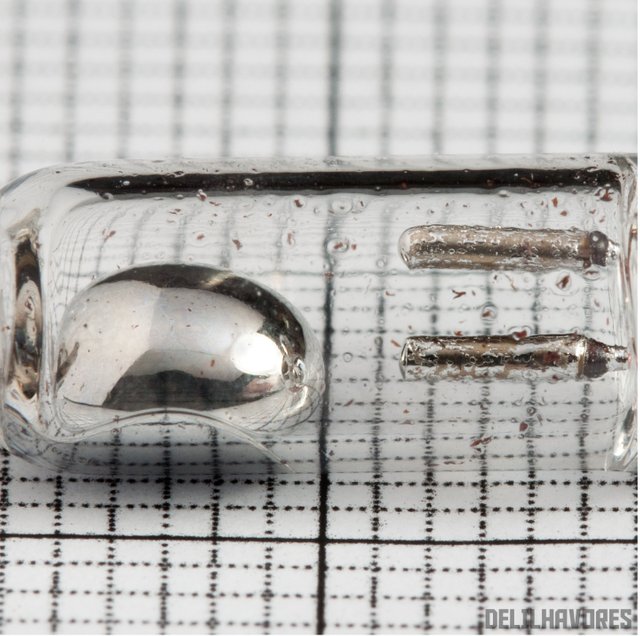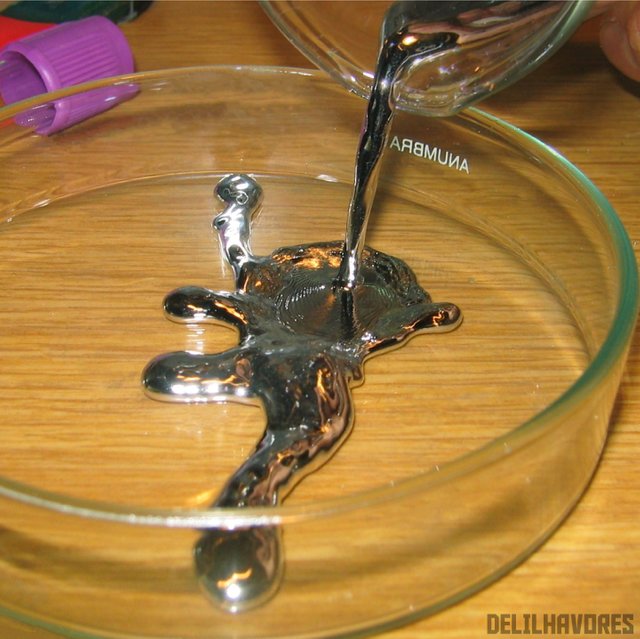Mercury in the periodic table of the elements – Il mercurio nella tavola periodica degli elementi
Introduction
Mercury is the chemical element with the symbol Hg (from "Hydrargyrum) and atomic number 80. We find it in three possible states of oxidation: 0, +1 and +2.
It is an oxidizing and liquid metal at room temperature. Mercury dissolves all metals giving rise to amalgam.
It has a high density (d = 13.6) but a very low vapor pressure at 20° C, so the vapors are very toxic. It dissolves in oxidizing acids, such as nitric acid, when hot.
The mercury ion Hg22+ is a dimer and is unstable. The mercury ion Hg2 + tends to give complex ions with coordination number = 4.

Biologic interactions
Mercury is a stimulatory element at very low concentrations (0.01-0.03 microg/L), but it can accumulate in tissues and give toxicity.
Mercurial compounds are very volatile and their direct inhalation is extremely harmful and causes professional poisoning. The toxicity can also derive from feeding: some mercury compounds are reduced by micro-organisms to dimethylmercury Hg (CH3)2, very fat-soluble, which accumulates in the tissues going up the food chain to fish for human food use.
Chronic mercury poisoning is called hydrargirism and presents the following symptoms: insomnia, tremors, deconcentration, decreased visual acuity, degeneration and necrosis of the renal tubules and mucous membranes.
The detoxification is carried out by chelation with dimercaprol, penicilamine and 2,3-dimercaptosuccinic acid.

Compounds of pharmaceutical interest
In the Pharmacopoeia there are numerous compounds of pharmaceutical interest containing mercury:
- Mercury oxide: It can be yellow and, for external use in preparations of mercury 1-5%, it has antiseptic properties in antieczematous ointments and in eye drops. Or it can also be red, and in this case it is used as an anti-algae in paints for ships. Red oxide has smaller particle sizes, which is why it cannot be used in the pharmaceutical field, as the increased surface causes excessive skin absorption;
- Mercury chloride: It is widely used from the end of the 1800s as an antiseptic for external use and as a disinfectant for surgical instruments (0.1%). Currently, prolonged use is not recommended due to high toxicity; it can also affect metals. Sublime easily and the sublimate is corrosive;
- Merbromine (mercurochrome): Sodium salt of the 2,7dibromo-4-hydroxymeric fluorescein. It is widely used as an antiseptic on wounds, burns and in surgery;
- Phenylmercury nitrate: It is a mixture of nitrate and phenylmercury hydroxide. The compound is antiseptic and antibacterial, but caustic at high concentrations. It is used in the formulation of some cosmetic products as a preservative;
- Phenylmercury borate: It is a mixture of phenylmercury borate and phenylmercury hydroxide. It is used as an antibacterial, antifungal, preservative and stabilizer in pharmaceutical preparations;
- Sodium ethylmercury tiosalicylate: It is a preservative and stabilizer in pharmaceutical preparations with antibacterial and antimicrobial action.
Historically, the mercurial diuretics that bind to the SH groups of the renal tubules are inactivating the enzymes responsible for the reabsorption of Na + and Cl-, increasing the diuresis. Nowadays they are no longer used because they cause necrosis of the renal tubules.

Analytic reactions
Regarding the recognition reactions of mercurial compounds, the mercurous ion (Hg2) has the tendency to dismute metallic Hg and Hg2+ ion:
Hg22+ --> Hg + Hg2 +
For the mercuric ion, instead:
- An acid solution of mercuric ion spontaneously deposits metallic mercury on a copper sheet:
Hg2+ + Cu --> Hg + Cu2+ - The aqueous solution, by addition of NaOH, gives a yellow precipitate of HgO:
Hg2+ + 2OH- --> HgO + H2O - With Na2S, in an acid environment, the precipitation of the black sulfide can occur:
Hg2+ + S2- --> HgS
HgS, due to its high insolubility (kps = 10-54), is soluble only in aqua regia (HCl / HNO3 3: 1) following the reaction:
3HgS + 2NO3- + 8H + + 12 Cl- --> 3[HgCl4]2- + 2NO + 3S + 2H2O
ITA
Introduzione
Il mercurio è l’elemento chimico con simbolo Hg (da “Hydrargyrum) e numero atomico 80. Lo troviamo in tre possibili stati di ossidazione: 0, +1 e +2.
È un metallo ossidante e liquido a temperatura ambiente. Il mercurio scioglie tutti i metalli dando origine ad amalgame.
Ha densità elevata (d=13.6) ma tensione di vapore a 20°C molto bassa, per cui i vapori sono molto tossici. Si scioglie in acidi ossidanti, come l’acido nitrico, a caldo.
Lo ione mercuroso Hg22+ è un dimero ed è instabile. Lo ione mercurico Hg2+ tende a dare ioni complessi con numero di coordinazione = 4.

Interazioni biologiche
Il mercurio è un elemento stimolatorio a bassissime concentrazioni (0.01-0.03 microg/L), ma si può accumulare nei tessuti e dare tossicità.
I composti mercuriali sono molto volatili e la loro inalazione diretta è estremamente nociva e causa di intossicazioni professionali. La tossicità può derivare anche dall’alimentazione: alcuni composti del mercurio vengono ridotti da microorganismi a dimetilmercurio Hg(CH3)2, molto liposolubile, che si accumula nei tessuti risalendo la catena alimentare fino ai pesci di uso alimentare umano.
L’intossicazione cronica da mercurio è chiamata idrargirismo e presenta i seguenti sintomi: insonnia, tremori, deconcentrazione, diminuzione dell’acutezza visiva, degenerazione e necrosi dei tubuli renali e delle mucose.
La detossificazione si effettua per chelazione con dimercaprolo, penicilammina e acido 2,3-dimercaptosuccinico.

Composti di interesse farmaceutico
In Farmacopea esistono numerosi composti di interesse farmaceutico contenenti mercurio:
- Ossido di mercurio: Può essere giallo e, per uso esterno in preparati di mercurio 1-5%, ha proprietà antisettiche in pomate antieczematose e in colliri. Oppure può essere anche rosso, e in questo caso è utilizzato come antialghe nelle vernici per le navi. L’ossido rosso presenta minori dimensioni delle particelle, per questo motivo non si può usare in campo farmaceutico, in quanto l’aumentata superficie determina un eccessivo assorbimento cutaneo;
- Mercurio cloruro: È largamente utilizzato dalla fine dell’800 come antisettico per uso esterno e come disinfettante dei ferri chirurgici (0.1%). Attualmente se ne sconsiglia l’uso prolungato a causa dell’elevata tossicità; inoltre può intaccare i metalli. Sublima facilmente e il sublimato è corrosivo;
- Merbromina (mercurocromo): Sale sodico della 2,7dibromo-4-idrossimercuri fluoresceina. È molto utilizzato come antisettico su ferite, ustioni e in chirurgia;
- Nitrato di fenilmercurio: È una miscela di nitrato e idrossido di fenilmercurio. Il composto è antisettico e antibatterico, ma caustico ad alte concentrazioni. Viene utilizzato nella formulazione di alcuni prodotti cosmetici come conservante;
- Borato di fenilmercurio: È una miscela di borato di fenilmercurio e idrossido di fenilmercurio. Viene utilizzato come antibatterico, antifungino, conservante e stabilizzante nelle preparazioni farmaceutiche;
- Sodio etilmercurio tiosalicilato: È un conservante e stabilizzante nelle preparazioni farmaceutiche ad azione antibatterica e antimicrobica.
Storicamente, sono importanti i diuretici mercuriali che si legano ai gruppi SH dei tubuli renali inattivando gli enzimi deputati al riassorbimento di Na+ e Cl-, aumentando la diuresi. Al giorno d’oggi non vengono più usati perché causano necrosi dei tubuli renali.

Reazioni analitiche
Per quanto riguarda le reazioni di riconoscimento dei composti mercuriali, lo ione mercuroso (Hg22+) ha la tendenza a dismutare a Hg metallico e ione Hg2+:
Hg22+ --> Hg + Hg2+
Per lo ione mercurico, invece:
- Una soluzione acida di ione mercurico deposita spontaneamente mercurio metallico su una lamina di rame:
Hg2+ + Cu --> Hg + Cu2+ - La soluzione acquosa, per aggiunta di NaOH, dà un precipitato giallo di HgO
Hg2+ + 2OH- --> HgO + H2O - Con Na2S, in ambiente acido, si può avere la precipitazione del solfuro nero:
Hg2+ + S2- --> HgS
HgS, per la sua alta insolubilità (kps = 10-54), è solubile solo in acqua regia (HCl/HNO3 3:1) a seguito della reazione:
3HgS + 2NO3- + 8H+ + 12 Cl- --> 3[HgCl4]2- + 2NO + 3S + 2H2O
Congratulations @delilhavores! You have completed the following achievement on the Steem blockchain and have been rewarded with new badge(s) :
You can view your badges on your Steem Board and compare to others on the Steem Ranking
If you no longer want to receive notifications, reply to this comment with the word
STOPTo support your work, I also upvoted your post!
Vote for @Steemitboard as a witness to get one more award and increased upvotes!
Hello,
Your post has been manually curated by a @stem.curate curator.
We are dedicated to supporting great content, like yours on the STEMGeeks tribe.
If you like what we are doing, please show your support as well by following our Steem Auto curation trail.
Please join us on discord.
This post was selected, voted and shared by the discovery-it curation team in collaboration with the C-Squared Curation Collective. You can use the #Discovery-it tag to make your posts easy to find in the eyes of the curator. We also encourage you to vote @c-squared as a witness to support this project.
ciao @delilhavores hai un account social dove posso contattarti?
ci proverò anch'io anche se mi sembrerebbe di difficile soluzione